 news
news
Pressure Washers: How They Work and Why You Need One
Contents
Pressure washers are an absolute game-changer for both homeowners and cleaning professionals. Whether you're blasting grime off a driveway, removing mold from siding, or prepping a deck for staining, understanding how pressure washers work can empower you to use them more effectively.
This blog breaks down everything you need to know, from the fundamentals of how they operate to tips on using them safely and efficiently.
If you're a homeowner looking to step up your cleaning game or an outdoor cleaning business aiming to better understand your tools, you've come to the right place.
What Is a Pressure Washer?
A pressure washer is a high-powered cleaning device that uses pressurized water to remove dirt, grime, and other contaminants from surfaces. It's far more efficient than traditional cleaning methods, making it a favorite for tackling tough outdoor cleaning tasks.
Key Components of a Pressure Washer
Here’s what you’ll find under the hood of a typical pressure washer and why it’s essential:
-
Motor: Powers the pump and determines the washer’s strength. Can be electric or gas-powered.
-
Pump: The heart of the pressure washer, it pressurizes the water to achieve cleaning power.
-
Hose: The conduit that delivers high-pressure water to the nozzle.
-
Nozzle: Controls the spray pattern and intensity, making it adjustable for different tasks (e.g., narrow jets for tough stains, wider sprays for delicate surfaces).
Each component works in harmony to generate the pressure and flow needed for powerful cleaning.
Basic Principle of How a Pressure Washer Works
At its core, a pressure washer operates by increasing water pressure. Water enters the washer at a low pressure (e.g., through a garden hose), and the machine’s pump increases that pressure drastically.
How It Works, Step by Step
-
Water Intake - Water flows into the pressure washer, usually via a garden hose connected to your home water supply.
-
Pressure Generation - The pump, powered by either an electric motor or a gas engine, pressurizes the water. This raises the pressure dramatically—often reaching up to 3,000 PSI (pounds per square inch) or more.
-
Water Delivery - The high-pressure water then travels through the hose and exits the nozzle.
-
Nozzle Adjustment - You can adjust the nozzle to control the spray pattern—choose a narrow spray for stubborn stains or a wide spray for delicate areas.
-
Cleaning Action - When the pressurized water hits a surface, it lifts dirt, grime, and other debris. The high velocity of water molecules does most of the work, minimizing the need for scrubbing or harsh chemicals.
A Quick Note on Power Sources
-
Electric Pressure Washers: Quieter, lighter, and perfect for smaller jobs. Plug them into a standard outlet, and you’re good to go.
-
Gas-Powered Pressure Washers: More powerful and better suited for heavy-duty or professional tasks, like cleaning large driveways or commercial areas.
Types of Pressure Washers and Their Differences
Choosing the right type of pressure washer depends on your specific needs. Here's a quick breakdown of the most common types.
Electric Pressure Washers
-
Benefits: Lightweight, low maintenance, easy to store.
-
Ideal For: Cars, outdoor furniture, small patios, and windows.
-
Drawbacks: Less power compared to gas models.
Gas-Powered Pressure Washers
-
Benefits: High cleaning power for large and tough tasks.
-
Ideal For: Driveways, siding, decks, and cleaning jobs on the go.
-
Drawbacks: Noisier, heavier, and requires more maintenance.
Hot Water vs. Cold Water Pressure Washers
-
Hot Water: Removes grease and oil more effectively. Usually used in commercial settings.
-
Cold Water: Better for general grime and most household tasks.
Key Factors Affecting Pressure Washer Performance
Here’s what you should know before firing up a pressure washer:
-
Water Pressure (PSI) - PSI determines the force of the water. Higher PSI values are great for tough stains but can damage delicate surfaces.
-
Flow Rate (GPM) - Measured in gallons per minute, the GPM indicates the volume of water your pressure washer emits, impacting how quickly you can clean larger areas.
-
Nozzle Types - Nozzles with narrow sprays deliver greater force but can damage surfaces if misused. Wider nozzles are safer for more delicate surfaces.
-
Surface Material - Always consider the surface you’re cleaning. For example, decks require lower pressure to prevent splintering, while driveways can handle higher PSI.
Common Pressure Washer Mistakes and How to Avoid Them
To get the most out of your pressure washer, avoid these common pitfalls:
-
Using Too Much Pressure - High PSI on delicate surfaces like wood or car paint can cause damage. Always test on a small area first.
-
Wrong Nozzle Use - Choosing the incorrect nozzle can lead to poor results or even surface damage. Use a nozzle chart to pick the right one for your task.
-
Skipping Maintenance - Clogged filters or old hoses can reduce performance. Regularly clean and inspect your pressure washer's parts to keep it in top condition.
Benefits of Using a Pressure Washer
Why should you add a pressure washer to your cleaning arsenal?
-
Saves Time and Effort - Tackle tough jobs in minutes that would otherwise take hours with a bucket and sponge.
-
Deep Cleaning - Reach areas and remove grime that traditional cleaning methods can't.
-
Eco-Friendly - Most pressure washers use less water and fewer chemicals than manual cleaning.
Want to Know More?
Pressure washers are versatile, powerful tools that save time and energy. By understanding how they work, you can maximize their performance and enjoy spotless results every time.
Need help finding the perfect pressure washer or accessories for your needs? Visit Everything Pressure Washing to shop top-tier equipment, from hoses to nozzles.
Don’t wait—get started on your cleaning projects today and make outdoor cleaning easier than ever.
